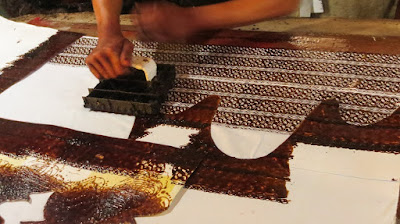 |
| Block print with wax on Cotton |
for our first blog post we thought it would be wise to tell you a little about Batik.We spend a lot of time in Batik ateliers and we have come to love this art more and more every year.
Some of you may know that Batik is a resist dye technique. 'Resist dye' is quite a hands-on term for what it describes,
which is, parts of the fabric are treated so they will resist the dye. There are many different resist-dye techniques like for example mud resist-dye and tie and dye. We will touch on those in a later post.For Batik the treatment is to cover certain areas of the fabric with hot, liquid wax so the fibers will not take the colour when dyed.
The image above and the first one below show you how our artisans apply hot wax on the cloth. In the first photo a block is used which creates a print of wax on the fabric.
In the second photo you can see a Canting, a type of pen if you will, which holds the liquid wax and allows the artist to draw on the fabric like you would with a pen. Also notice in the second photo that the fabric has already undergone one dye-bath. Therefore this is the second application of the wax to create the desired motif.
Now of course we need to explain what it is, "to dye" fabric. When fabric lovers use the term dye it always refers to a colour that will be applied in a bath, a dye-bath.
The fabric will be completely immersed in the dye and the artisan will apply his knowledge to make sure the dye impregnates the fabric evenly.
On this photo you see an artisan dying cotton in Indigo.
 |
| Indigo Dyeing |
If areas of the fabric have been covered with wax then, after the dye-bath, the wax will be removed by boiling the fabric and melting the wax so that the motif would become visible.
We hope this post gave you some more insight in the basic Batik process. In our workshops all the different steps are completely hand done. The fact that people are responsible for all these different steps (and not machines) has some consequences.
The application of wax may be slightly different every time the block hits the fabric, the hand of the artist may draw the same motif with a slightly different flow or the shade of colour may be a bit darker or lighter when dyeing etc.
This makes for truly unique pieces of fabric.
Before we leave you we like to share one more photo.
A sunny courtyard in one of our artisans home.
As Batik is a traditional craft, many of our fabrics are made in the homes of the artisans.
Here you can see some freshly finished fabrics drying in the sun.
 |
| Batik drying on sunny courtyard |
That's it for now, thank you for visiting our blog.
We look forward to welcome you again.
We look forward to welcome you again.
Marijke Jordens

